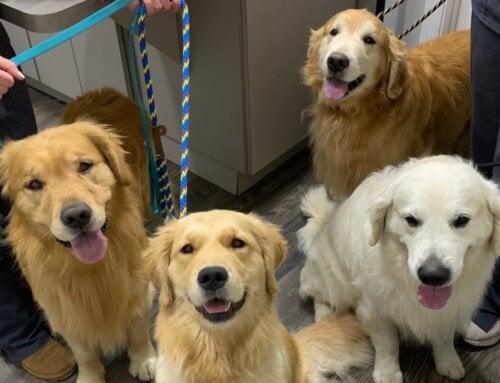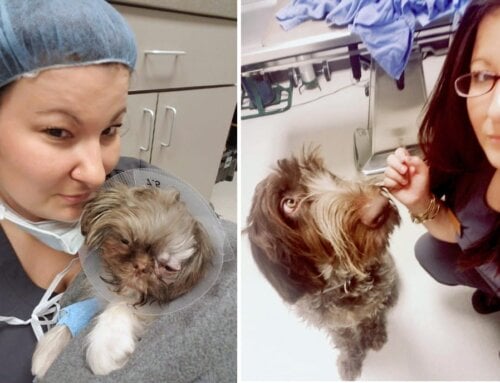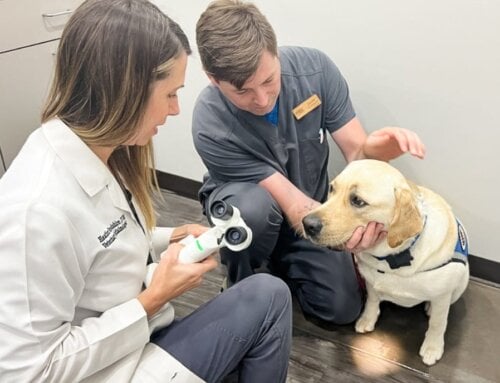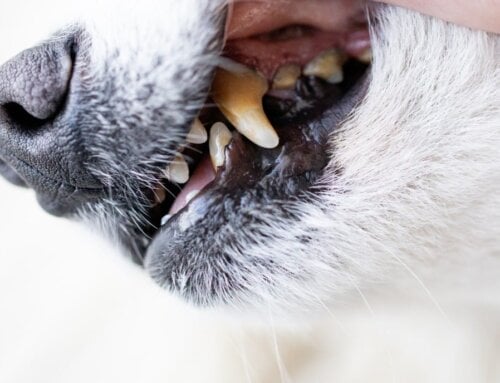By Heather Brookshire, DVM, DAVCO
We see a lot of dogs at our practice, but we give equal time to our feline patients too! Cats can develop a number of ocular conditions, and we thought it would be helpful to outline some of the common eye issues in cats and how we treat them.
To start, let’s look at one of the most prevalent causes of ocular disease in cats—Feline Herpesvirus (FHV-1). Common and highly contagious, this viral upper respiratory infection in cats is spread by oral, nasal and conjunctival routes. Most cats are exposed to FHV-1 from their mothers during the first few weeks of life. The virus directly infects and damages the epithelial lining of the upper respiratory tract, as well as the ocular surface and surrounding tissues.
The symptoms of upper respiratory infection can include: fever, lethargy, sneezing, nasal congestion and discharge, ocular discharge and conjunctivitis. Typically, these clinical signs only last for 2-3 weeks; however some cats become latently infected and periodically shed the virus throughout their life during times of stress or illness. Recurrent infections are often less severe than initial infections and may include only ocular signs such as conjunctivitis and corneal ulceration.
Once infected, symptoms can be treated with antibiotics and/or antiviral medications to ease symptoms. While many cases come under complete control within just a few days to weeks, some cases will ultimately require surgical correction, in addition to medical therapy.
Common secondary conditions
Secondary clinical conditions that can result from FHV-1 include:
- Entropion – Chronic, untreated or ineffectively treated FHV-1 can result in persistent squinting/tension within the eyelid muscles, which can lead to secondary inversion or rolling inward of the eyelids. This allows the haired portion of the eyelid to rub on the cornea, causing persistent irritation and discomfort.
- Symblepharon – This condition is typically the result of a severe herpesvirus infection, in which both the epithelial surfaces (top layer) of the cornea and conjunctiva are ulcerated, and subsequently heal together. Symblepharon can be mild and result in only slight alterations in ocular surface dynamics, such as tear flow and/or third eyelid mobility. Or, it can lead to near-complete blindness if the adhesions are severe.
- Corneal sequestrum – Corneal sequestrums are regions of dead/necrotic cornea. This lesion is caused by either chronic irritation to the corneal surface, physiologic exophthalmos (“buggy”/prominent eyes) in Persian, Himalayan and Burmese cats, or chronic ulceration associated with herpesvirus infection. The lesion is fairly easily recognized by the brown discoloration of the cornea; however, there is a wide spectrum of appearances, anywhere from a faint, superficial amber hue, to a deep, dark black plaque within the corneal stroma.
- Eosinophilic keratoconjunctivitis – This condition is an immune-mediated consequence of previous herpesvirus infection. The characteristic lesion consists of dense white, chalky lesions and pink/mass-like granulation tissue within the cornea. Cytology of these lesions will reveal eosinophils and mast cells, which are otherwise not present in the normal cornea.
- Stromal keratitis – Another immune manifestation of previous herpesvirus infection, stromal keratitis is thought to result from a lingering presence of viral antigen within the corneal stroma. The characteristic lesion, in this case, is the nonulcerative keratitis, which is seen as vascularization of the corneal stroma, with associated edema and hazy white cellular infiltrate.
- Decreased tear production – This condition can result either from direct inflammation of the tear-producing gland or from scar tissue formation and damage to the epithelial lining of the ducts of the tear glands.
Treating Feline Herpesvirus
Medical therapy for FHV-1 infections involves providing supportive care, managing complications from the symptoms and attempting to shorten the duration of clinical signs. These options include:
- Antiviral therapy – Famciclovir (oral), Cidofovir (topical)
- Neutroceuticals – L-lysine, probiotics; to reduce viral shedding and strengthen the immune system
- Antibiotic therapy – to reduce risk of secondary infection of corneal ulcers
- Lubricants – to provide comfort and improve tear film irregularities
- Immunomodulatory therapy – Cyclosporine, Tacrolimus; to minimize secondary immune manifestations of FHV-1
Medical and surgical therapies
Several manifestations of FHV-1 require surgical correction, in addition to medical therapy. This includes entropion, corneal sequestrum and some cases of symblepharon formation. Entropion surgery is performed by removing an elliptical section of the eyelid skin and underlying muscle to roll out the eyelid margin and eliminate chronic irritation to the ocular surface. Very few cases of corneal sequestrum fully heal with medical therapy, and instead require surgical excision of the dead corneal tissue (keratectomy), often followed by graft placement over the affected area to help prevent recurrence. When symblepharon causes vision-altering changes to the ocular surface, surgical breakdown of the adhesions should be considered.
Can my cat spread it to others?
FHV-1 is extremely contagious from cat to cat. In most cases, however, if two cats are living together and only one cat has clinical signs of FHV-1 infection, the other cat has likely been infected but is less predisposed to recurrent bouts of infection. While this infection is transmissible between cats, it cannot spread to people. For more information on Felines Herpesvirus, check for our brochure in our Virtual Library at this link. These are also available in our clinic.
Visit our virtual library to learn more about Feline Herpesvirus & Treatment
















